run flat SMART FORTWO COUPE 2010 Owners Manual
[x] Cancel search | Manufacturer: SMART, Model Year: 2010, Model line: FORTWO COUPE, Model: SMART FORTWO COUPE 2010Pages: 216, PDF Size: 9.7 MB
Page 7 of 216
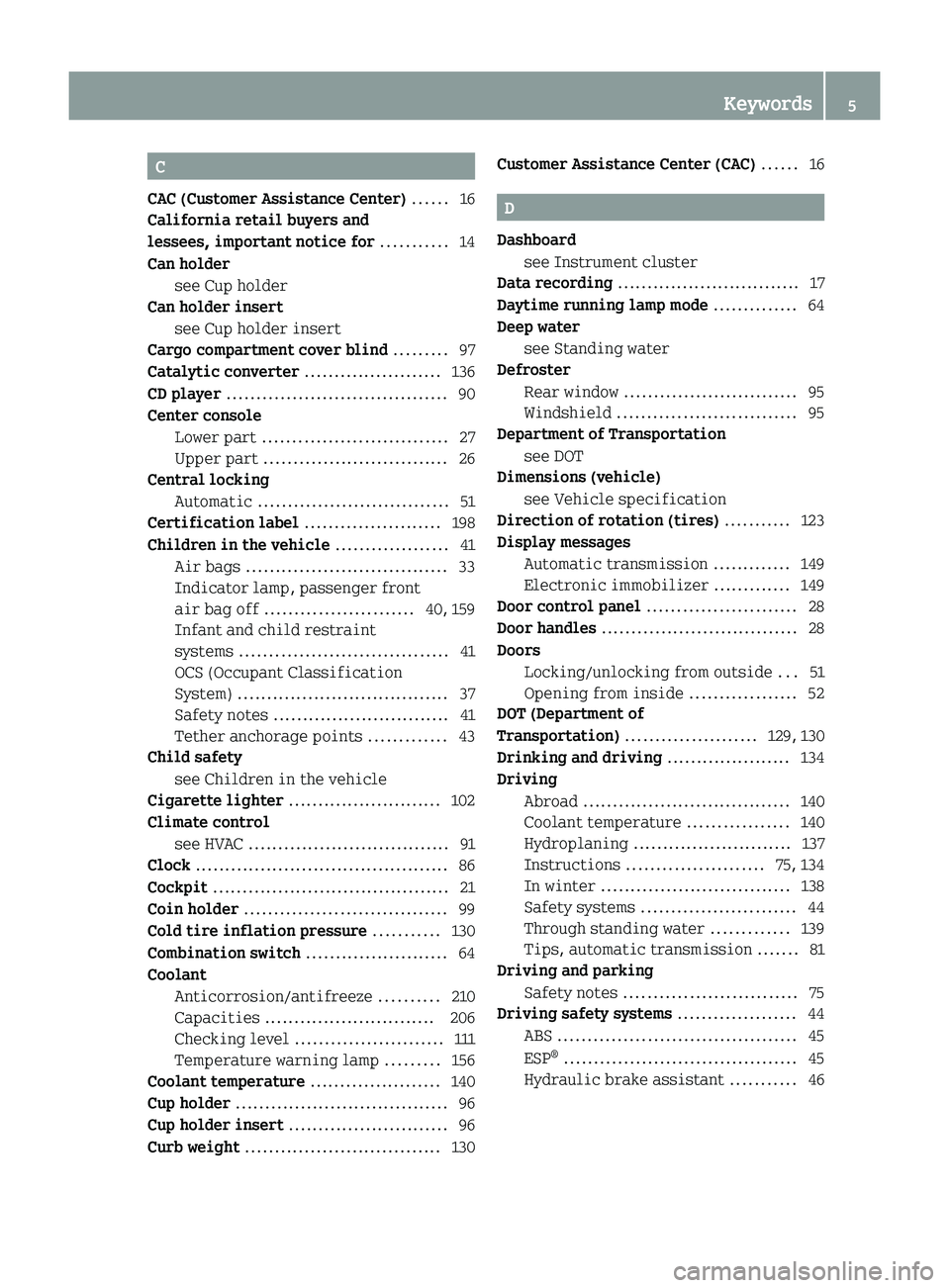
C
CAC (Customer Assistance Center) ...... 16
California retail buyers and
lessees, important notice for ........... 14
Can holder see Cup holder
Can holder insert
see Cup holder insert
Cargo compartment cover blind ......... 97
Catalytic converter ....................... 136
CD player ..................................... 90
Center console
Lower part ............................... 27
Upper part ............................... 26
Central locking
Automatic ................................ 51
Certification label ....................... 198
Children in the vehicle ................... 41
Air bags .................................. 33
Indicator lamp, passenger front
air bag off ......................... 40, 159
Infant and child restraint
systems ................................... 41
OCS (Occupant Classification
System) .................................... 37
Safety notes .............................. 41
Tether anchorage points .............43
Child safety
see Children in the vehicle
Cigarette lighter .......................... 102
Climate control
see HVAC .................................. 91
Clock ........................................... 86
Cockpit ........................................ 21
Coin holder .................................. 99
Cold tire inflation pressure ........... 130
Combination switch ........................ 64
Coolant
Anticorrosion/antifreeze ..........210
Capacities ............................. 206
Checking level ......................... 111
Temperature warning lamp .........156
Coolant temperature ...................... 140
Cup holder .................................... 96
Cup holder insert ........................... 96
Curb weight ................................. 130Customer Assistance Center (CAC) ...... 16
D
Dashboard see Instrument cluster
Data recording ............................... 17
Daytime running lamp mode .............. 64
Deep water see Standing water
Defroster
Rear window ............................. 95
Windshield .............................. 95
Department of Transportation
see DOT
Dimensions (vehicle)
see Vehicle specification
Direction of rotation (tires) ........... 123
Display messages
Automatic transmission .............149
Electronic immobilizer .............149
Door control panel ......................... 28
Door handles ................................. 28
Doors
Locking/unlocking from outside ...51
Opening from inside ..................52
DOT (Department of
Transportation) ...................... 129, 130
Drinking and driving ..................... 134
Driving
Abroad ................................... 140
Coolant temperature .................140
Hydroplaning ........................... 137
Instructions ....................... 75, 134
In winter ................................ 138
Safety systems .......................... 44
Through standing water .............139
Tips, automatic transmission .......81
Driving and parking
Safety notes ............................. 75
Driving safety systems .................... 44
ABS ........................................ 45
ESP ®
....................................... 45
Hydraulic brake assistant ...........46
Keywords5451_AKB; 3; 22, en-USd2ureepe,Version: 2.11.8.12009-07-27T09:36:34+02:00 - Seite 5
Page 9 of 216
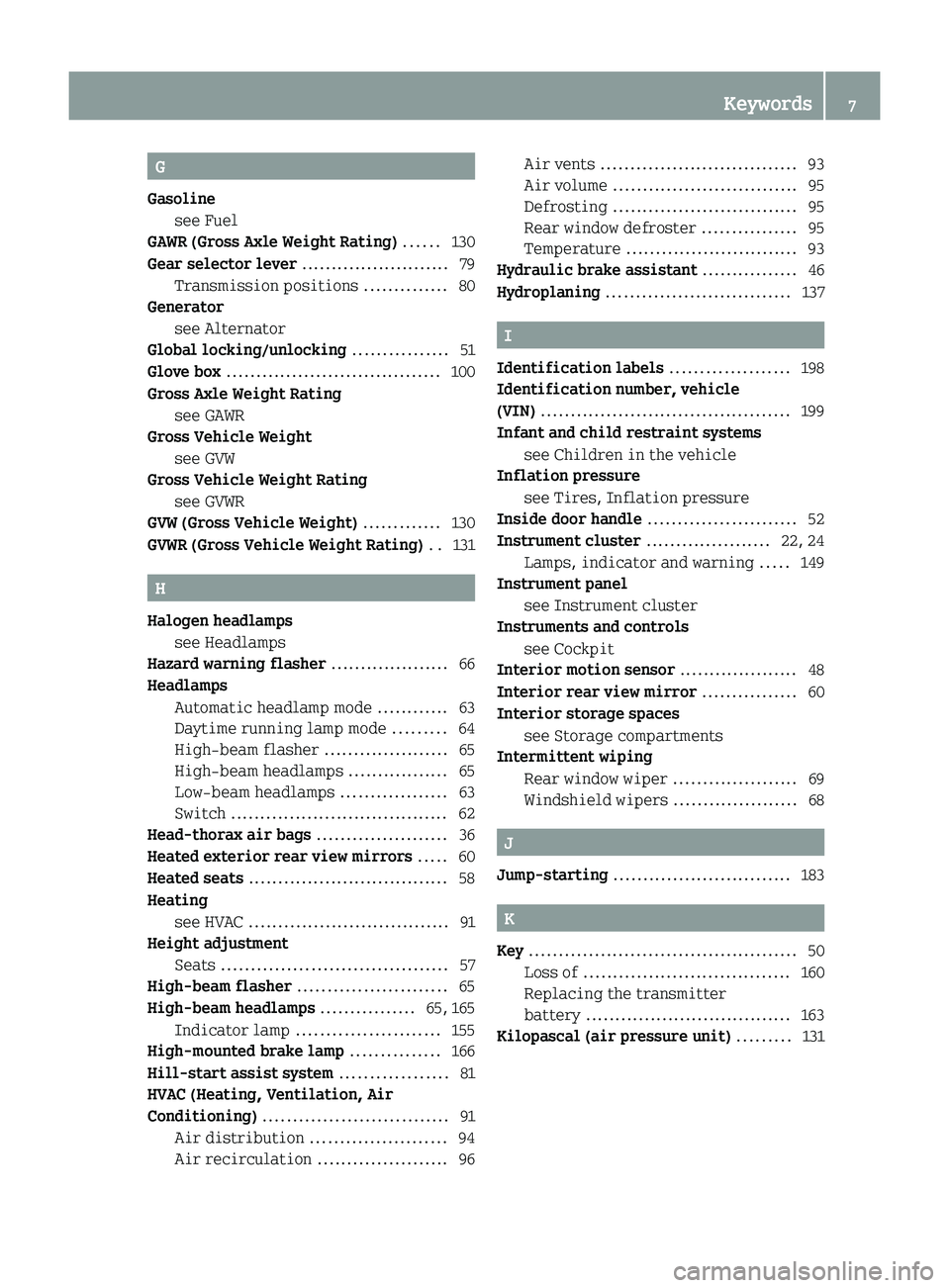
G
Gasoline see Fuel
GAWR (Gross Axle Weight Rating) ...... 130
Gear selector lever ......................... 79
Transmission positions ..............80
Generator
see Alternator
Global locking/unlocking ................ 51
Glove box .................................... 100
Gross Axle Weight Rating see GAWR
Gross Vehicle Weight
see GVW
Gross Vehicle Weight Rating
see GVWR
GVW (Gross Vehicle Weight) ............. 130
GVWR (Gross Vehicle Weight Rating) .. 131
H
Halogen headlamps see Headlamps
Hazard warning flasher .................... 66
Headlamps
Automatic headlamp mode ............63
Daytime running lamp mode .........64
High-beam flasher .....................65
High-beam headlamps ................. 65
Low-beam headlamps ..................63
Switch ..................................... 62
Head-thorax air bags ...................... 36
Heated exterior rear view mirrors ..... 60
Heated seats .................................. 58
Heating
see HVAC .................................. 91
Height adjustment
Seats ...................................... 57
High-beam flasher ......................... 65
High-beam headlamps ................ 65, 165
Indicator lamp ........................ 155
High-mounted brake lamp ............... 166
Hill-start assist system .................. 81
HVAC (Heating, Ventilation, Air
Conditioning) ............................... 91
Air distribution ....................... 94
Air recirculation ...................... 96
Air vents ................................. 93
Air volume ............................... 95
Defrosting ............................... 95
Rear window defroster ................95
Temperature ............................. 93
Hydraulic brake assistant ................ 46
Hydroplaning ............................... 137
I
Identification labels .................... 198
Identification number, vehicle
(VIN) .......................................... 199
Infant and child restraint systems see Children in the vehicle
Inflation pressure
see Tires, Inflation pressure
Inside door handle ......................... 52
Instrument cluster ..................... 22, 24
Lamps, indicator and warning .....149
Instrument panel
see Instrument cluster
Instruments and controls
see Cockpit
Interior motion sensor .................... 48
Interior rear view mirror ................ 60
Interior storage spaces see Storage compartments
Intermittent wiping
Rear window wiper .....................69
Windshield wipers .....................68
J
Jump-starting .............................. 183
K
Key ............................................. 50
Loss of ................................... 160
Replacing the transmitter
battery ................................... 163
Kilopascal (air pressure unit) ......... 131
Keywords7451_AKB; 3; 22, en-USd2ureepe,Version: 2.11.8.12009-07-27T09:36:34+02:00 - Seite 7
Page 10 of 216
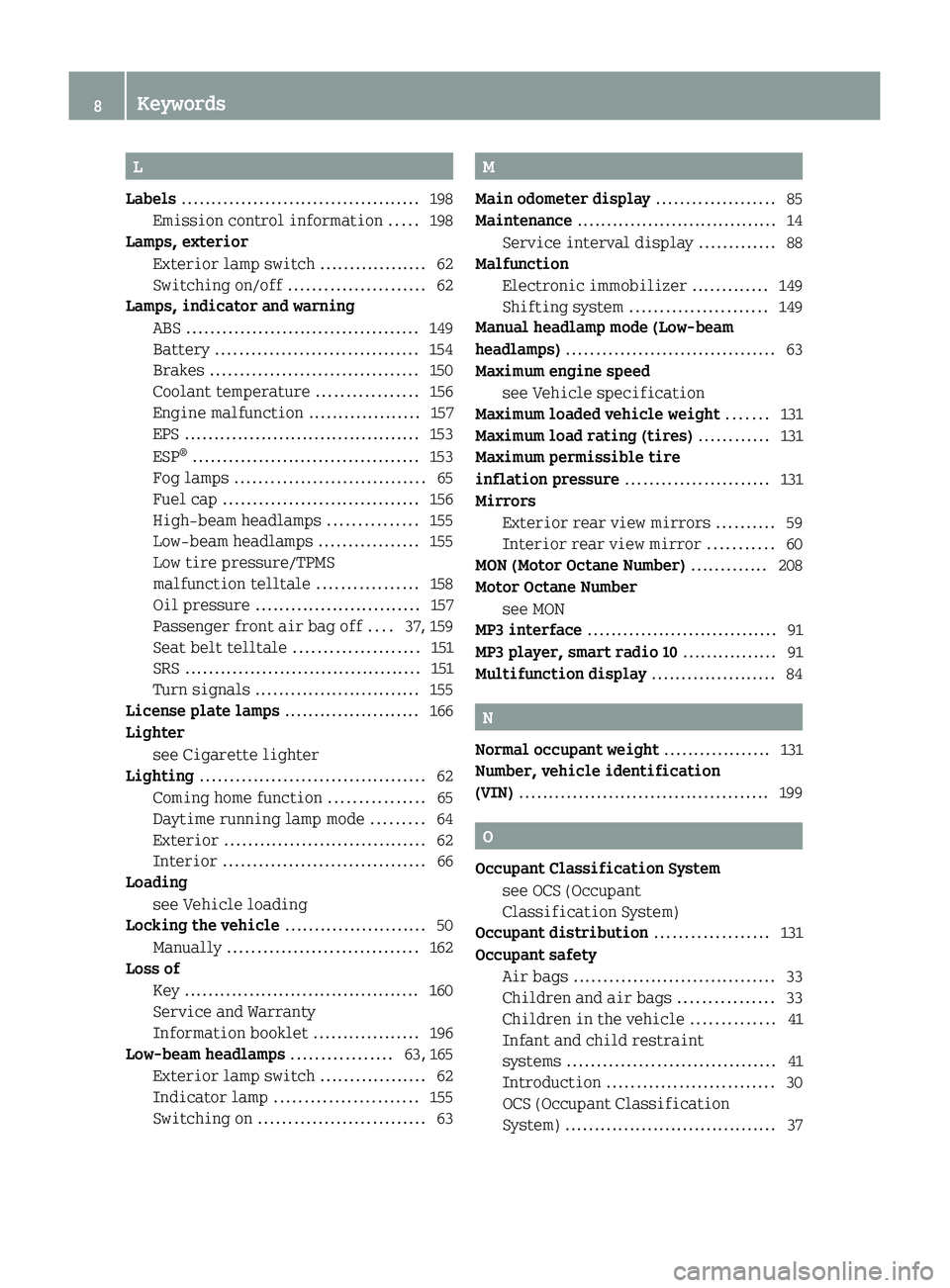
L
Labels ........................................ 198
Emission control information .....198
Lamps, exterior
Exterior lamp switch ..................62
Switching on/off ....................... 62
Lamps, indicator and warning
ABS ....................................... 149
Battery .................................. 154
Brakes ................................... 150
Coolant temperature .................156
Engine malfunction ...................157
EPS ........................................ 153
ESP ®
...................................... 153
Fog lamps ................................ 65
Fuel cap ................................. 156
High-beam headlamps ...............155
Low-beam headlamps .................155
Low tire pressure/TPMS
malfunction telltale .................158
Oil pressure ............................ 157
Passenger front air bag off ....37, 159
Seat belt telltale ..................... 151
SRS ........................................ 151
Turn signals ............................ 155
License plate lamps ....................... 166
Lighter see Cigarette lighter
Lighting ...................................... 62
Coming home function ................65
Daytime running lamp mode .........64
Exterior .................................. 62
Interior .................................. 66
Loading
see Vehicle loading
Locking the vehicle ........................ 50
Manually ................................ 162
Loss of
Key ........................................ 160
Service and Warranty
Information booklet ..................196
Low-beam headlamps ................. 63, 165
Exterior lamp switch ..................62
Indicator lamp ........................ 155
Switching on ............................ 63M
Main odometer display .................... 85
Maintenance .................................. 14
Service interval display .............88
Malfunction
Electronic immobilizer .............149
Shifting system ....................... 149
Manual headlamp mode (Low-beam
headlamps) ................................... 63
Maximum engine speed see Vehicle specification
Maximum loaded vehicle weight ....... 131
Maximum load rating (tires) ............ 131
Maximum permissible tire
inflation pressure ........................ 131
Mirrors
Exterior rear view mirrors ..........59
Interior rear view mirror ...........60
MON (Motor Octane Number) ............. 208
Motor Octane Number see MON
MP3 interface ................................ 91
MP3 player, smart radio 10 ................ 91
Multifunction display ..................... 84
N
Normal occupant weight .................. 131
Number, vehicle identification
(VIN) .......................................... 199
O
Occupant Classification System see OCS (Occupant
Classification System)
Occupant distribution ................... 131
Occupant safety
Air bags .................................. 33
Children and air bags ................33
Children in the vehicle ..............41
Infant and child restraint
systems ................................... 41
Introduction ............................ 30
OCS (Occupant Classification
System) .................................... 37
8Keywords451_AKB; 3; 22, en-USd2ureepe,Version: 2.11.8.12009-07-27T09:36:34+02:00 - Seite 8
Page 32 of 216
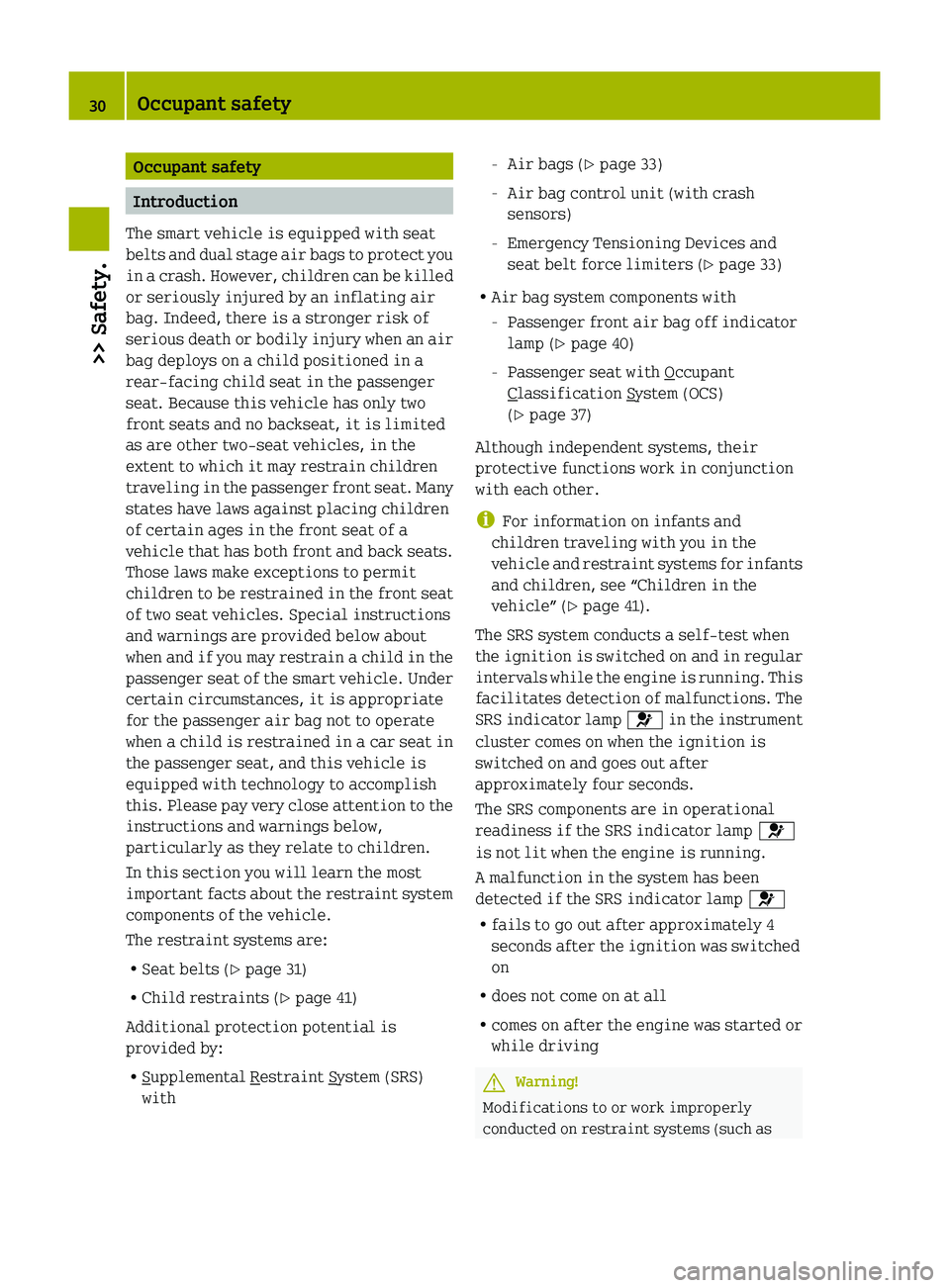
Occupant safety
Introduction
The smart vehicle is equipped with seat
belts and dual stage air bags to protect you
in a crash. However, children can be killed
or seriously injured by an inflating air
bag. Indeed, there is a stronger risk of
serious death or bodily injury when an air
bag deploys on a child positioned in a
rear-facing child seat in the passenger
seat. Because this vehicle has only two
front seats and no backseat, it is limited
as are other two-seat vehicles, in the
extent to which it may restrain children
traveling in the passenger front seat. Many
states have laws against placing children
of certain ages in the front seat of a
vehicle that has both front and back seats.
Those laws make exceptions to permit
children to be restrained in the front seat
of two seat vehicles. Special instructions
and warnings are provided below about
when and if you may restrain a child in the
passenger seat of the smart vehicle. Under
certain circumstances, it is appropriate
for the passenger air bag not to operate
when a child is restrained in a car seat in
the passenger seat, and this vehicle is
equipped with technology to accomplish
this. Please pay very close attention to the
instructions and warnings below,
particularly as they relate to children.
In this section you will learn the most
important facts about the restraint system
components of the vehicle.
The restraint systems are:
R Seat belts ( Y page 31)
R Child restraints ( Y page 41)
Additional protection potential is
provided by:
R
Supplemental Restraint System (SRS)
with
- Air bags ( Y page 33)
- Air bag control unit (with crash
sensors)
- Emergency Tensioning Devices and
seat belt force limiters ( Y page 33)
R Air bag system components with
- Passenger front air bag off indicator
lamp ( Y page 40)
- Passenger seat with
Occupant
Classification System (OCS)
( Y page 37)
Although independent systems, their
protective functions work in conjunction
with each other.
i For information on infants and
children traveling with you in the
vehicle and restraint systems for infants
and children, see “Children in the
vehicle” ( Y page 41).
The SRS system conducts a self-test when
the ignition is switched on and in regular
intervals while the engine is running. This
facilitates detection of malfunctions. The
SRS indicator lamp 0081 in the instrument
cluster comes on when the ignition is
switched on and goes out after
approximately four seconds.
The SRS components are in operational
readiness if the SRS indicator lamp 0081
is not lit when the engine is running.
A malfunction in the system has been
detected if the SRS indicator lamp 0081
R fails to go out after approximately 4
seconds after the ignition was switched
on
R does not come on at all
R comes on after the engine was started or
while driving
GWarning!
Modifications to or work improperly
conducted on restraint systems (such as
30Occupant safety>> Safety.
451_AKB; 3; 22, en-USd2ureepe,Version: 2.11.8.12009-07-27T09:36:34+02:00 - Seite 30
Page 139 of 216

RNever run the fuel tank empty.
R If the engine starts to misfire, bring the
vehicle to an immediate standstill
without endangering traffic.
R If the engine fails to start the first time,
you should not try to start it any more
than three times in succession.
R Do not try to start for more than four
seconds at a time.
Tires
GWarning!
If you feel a sudden significant vibration
or ride disturbance, or you suspect that
possible damage to your vehicle has
occurred, you should turn on the hazard
warning flashers, carefully slow down, and
drive with caution to an area which is a safe
distance from the road.
Inspect the tires and the vehicle underbody
for possible damage. If the vehicle or tires
appear unsafe, have the vehicle towed to the
nearest smart center or tire dealer for
repairs.
Treadwear indicators (TWI) are required by
law. These indicators are located in six
places on the tread circumference and
become visible at a tread depth of
approximately 1
/ 16 in (1.6 mm), at which
point the tire is considered worn and
should be replaced.
The treadwear indicator appears as a solid
band across the tread.
GWarning!
Although the applicable federal motor
vehicle safety laws consider a tire to be
worn when the treadwear indicators (TWI)
become visible at approximately 1
/ 16 in
(1.6 mm), we recommend that you do not allow
your tires to wear down to that level. As
tread depth approaches 1
/ 8 in (3 mm), the
adhesion properties on a wet road are
sharply reduced.
Depending upon the weather and/or road
surface (conditions), the tire traction
varies widely.
Specified tire inflation pressures must be
maintained. This applies particularly if
the tires are subject to high loads (e.g.
high speeds, heavy loads, high ambient
temperatures).GWarning!
Do not drive with a flat tire. A flat tire will
affect your ability to steer or brake and may
cause you to lose control of the vehicle.
Continued driving with a flat tire or
driving at high speed with a flat tire will
cause excessive heat build-up and possibly
a fire.
For more information, see “Tires and
wheels” ( Y page 114).
Hydroplaning
Depending on the depth of the water layer
on the road, hydroplaning may occur
resulting in a loss of control, even at low
speeds and with new tires. Reduce vehicle
speed, avoid track grooves in the road and
apply brakes cautiously when it is raining.
Tire traction
The safe speed on a wet, snow covered or icy
road is always lower than on a dry road.
You should pay particular attention to the
condition of the road whenever the outside
temperatures are close to the freezing
point.
GWarning!
If ice has formed on the road, tire traction
will be substantially reduced. Under such
weather conditions, drive, steer and brake
with extreme caution.
Driving instructions137>> Operation.451_AKB; 3; 22, en-USd2ureepe,Version: 2.11.8.12009-07-27T09:36:34+02:00 - Seite 137Z
Page 177 of 216
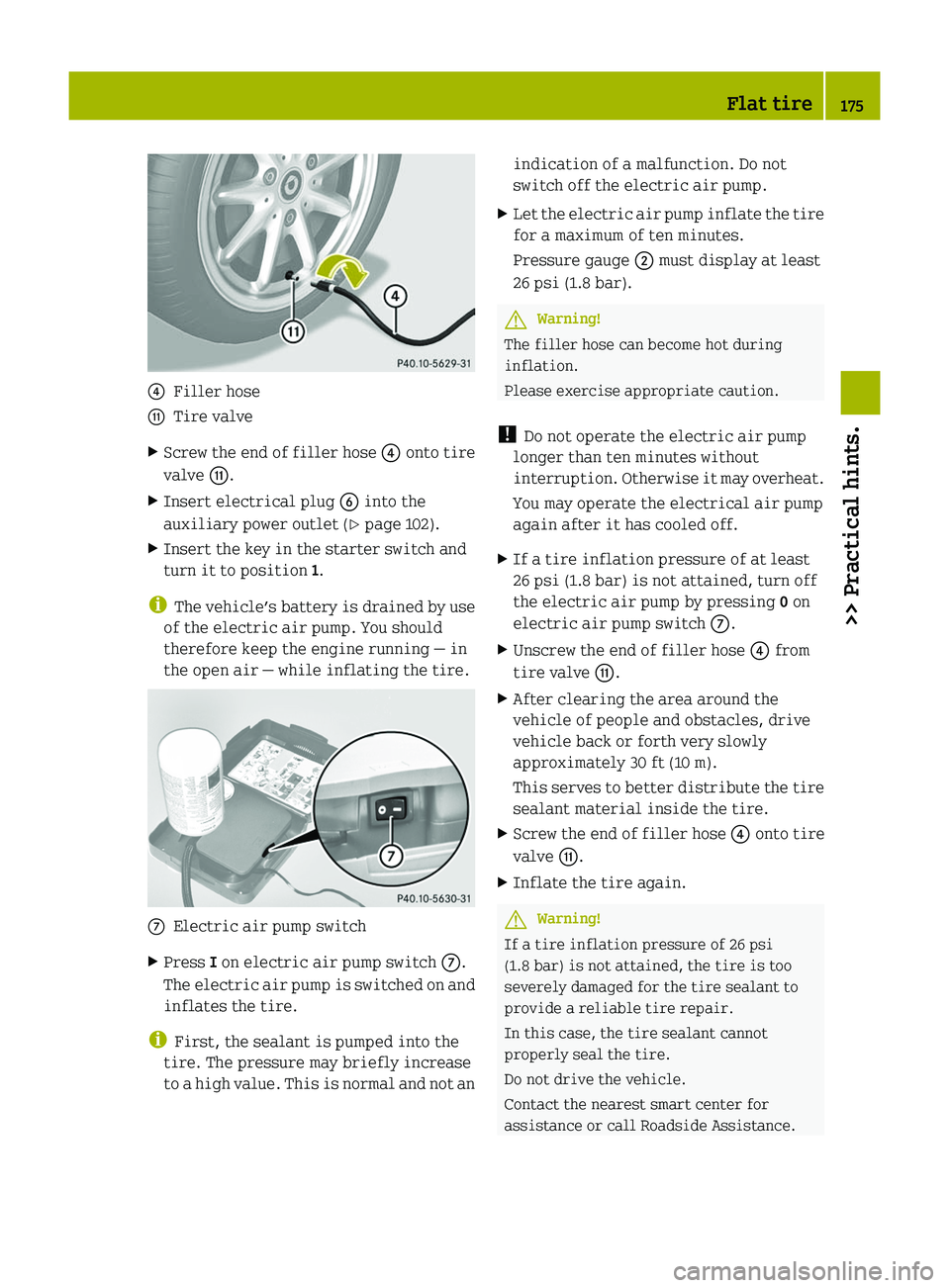
0088Filler hose0072Tire valveXScrew the end of filler hose 0088 onto tire
valve 0072.XInsert electrical plug 0087 into the
auxiliary power outlet ( Y page 102).XInsert the key in the starter switch and
turn it to position 1.
i
The vehicle’s battery is drained by use
of the electric air pump. You should
therefore keep the engine running — in
the open air — while inflating the tire.
006EElectric air pump switchXPress I on electric air pump switch 006E.
The electric air pump is switched on and
inflates the tire.
i First, the sealant is pumped into the
tire. The pressure may briefly increase
to a high value. This is normal and not an
indication of a malfunction. Do not
switch off the electric air pump.XLet the electric air pump inflate the tire
for a maximum of ten minutes.
Pressure gauge 0047 must display at least
26 psi (1.8 bar).GWarning!
The filler hose can become hot during
inflation.
Please exercise appropriate caution.
! Do not operate the electric air pump
longer than ten minutes without
interruption. Otherwise it may overheat.
You may operate the electrical air pump
again after it has cooled off.
XIf a tire inflation pressure of at least
26 psi (1.8 bar) is not attained, turn off
the electric air pump by pressing 0 on
electric air pump switch 006E.XUnscrew the end of filler hose 0088 from
tire valve 0072.XAfter clearing the area around the
vehicle of people and obstacles, drive
vehicle back or forth very slowly
approximately 30 ft (10 m).
This serves to better distribute the tire
sealant material inside the tire.XScrew the end of filler hose 0088 onto tire
valve 0072.XInflate the tire again.GWarning!
If a tire inflation pressure of 26 psi
(1.8 bar) is not attained, the tire is too
severely damaged for the tire sealant to
provide a reliable tire repair.
In this case, the tire sealant cannot
properly seal the tire.
Do not drive the vehicle.
Contact the nearest smart center for
assistance or call Roadside Assistance.
Flat tire175>> Practical hints.451_AKB; 3; 22, en-USd2ureepe,Version: 2.11.8.12009-07-27T09:36:34+02:00 - Seite 175Z
Page 187 of 216
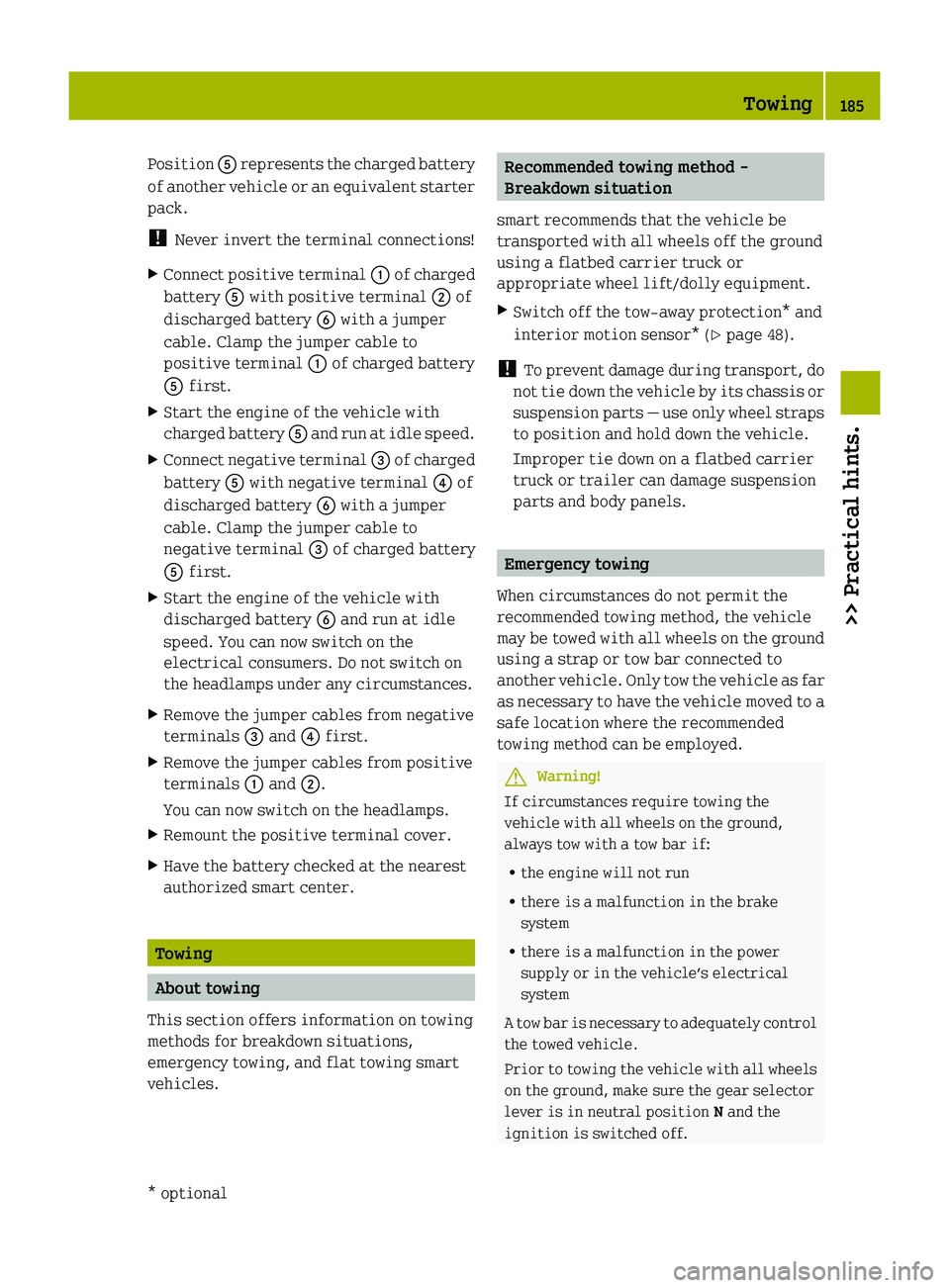
Position 0086 represents the charged battery
of another vehicle or an equivalent starter
pack.
! Never invert the terminal connections!XConnect positive terminal 0046 of charged
battery 0086 with positive terminal 0047 of
discharged battery 0087 with a jumper
cable. Clamp the jumper cable to
positive terminal 0046 of charged battery
0086 first.XStart the engine of the vehicle with
charged battery 0086 and run at idle speed.XConnect negative terminal 008A of charged
battery 0086 with negative terminal 0088 of
discharged battery 0087 with a jumper
cable. Clamp the jumper cable to
negative terminal 008A of charged battery
0086 first.XStart the engine of the vehicle with
discharged battery 0087 and run at idle
speed. You can now switch on the
electrical consumers. Do not switch on
the headlamps under any circumstances.XRemove the jumper cables from negative
terminals 008A and 0088 first.XRemove the jumper cables from positive
terminals 0046 and 0047.
You can now switch on the headlamps.XRemount the positive terminal cover.XHave the battery checked at the nearest
authorized smart center.
Towing
About towing
This section offers information on towing
methods for breakdown situations,
emergency towing, and flat towing smart
vehicles.
Recommended towing method -
Breakdown situation
smart recommends that the vehicle be
transported with all wheels off the ground
using a flatbed carrier truck or
appropriate wheel lift/dolly equipment.XSwitch off the tow‑away protection* and
interior motion sensor* ( Y page 48).
!
To prevent damage during transport, do
not tie down the vehicle by its chassis or
suspension parts — use only wheel straps
to position and hold down the vehicle.
Improper tie down on a flatbed carrier
truck or trailer can damage suspension
parts and body panels.
Emergency towing
When circumstances do not permit the
recommended towing method, the vehicle
may be towed with all wheels on the ground
using a strap or tow bar connected to
another vehicle. Only tow the vehicle as far
as necessary to have the vehicle moved to a
safe location where the recommended
towing method can be employed.
GWarning!
If circumstances require towing the
vehicle with all wheels on the ground,
always tow with a tow bar if:
R the engine will not run
R there is a malfunction in the brake
system
R there is a malfunction in the power
supply or in the vehicle’s electrical
system
A tow bar is necessary to adequately control
the towed vehicle.
Prior to towing the vehicle with all wheels
on the ground, make sure the gear selector
lever is in neutral position N and the
ignition is switched off.
Towing185>> Practical hints.* optional451_AKB; 3; 22, en-USd2ureepe,Version: 2.11.8.12009-07-27T09:36:34+02:00 - Seite 185Z